
The Laccadive or Kannur Islands are one of the three island subgroups in the Union Territory of Lakshadweep, India. It is the central subgroup of the Lakshadweep, separated from the Amindivi Islands subgroup roughly by the 11th parallel north and from the atoll of Minicoy (Maliku)—far to the south—by the 9 Degree or Mamala Channel.
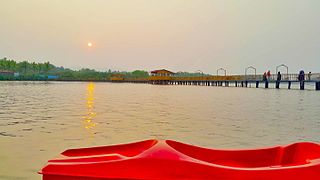
Kannur is one of the 14 districts along the west coast in the state of Kerala, India. The city of Kannur is the district headquarters and gives the district its name. The old name, Cannanore, is the anglicized form of the Malayalam name "Kannur". Kannur district is bounded by Kasaragod District to the north, Kozhikode district to the south, Mahé district to the southwest and Wayanad District to the southeast. To the east, the district is bounded by the Western Ghats, which forms the border with the state of Karnataka. The Arabian Sea lies to the west. Paithalmala is the highest point in Kannur District (1,372m). Enclosed within the southern part of the district is the Mahé district of the Union Territory of Puducherry. The district was established in 1957.
Kannur, formerly Cannanore, is a city in the Indian state of Kerala.
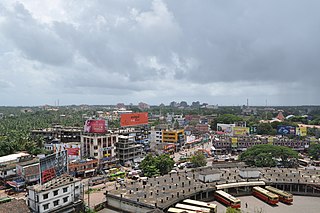
Kannur, formerly known in English as Cannanore, is a city and a municipal corporation in the state of Kerala, India. It is the administrative headquarters of the Kannur district and situated 274 kilometres (170 mi) north of the major port city and commercial hub Kochi and 137 kilometres (85 mi) south of the major port city and a commercial hub, Mangalore. During the period of British colonial rule in India, when Kannur was a part of the Malabar District, the city was known as Cannanore. Kannur is the fifth largest urban agglomeration in Kerala. As of 2011 census, Kannur Municipal Corporation, the local body which administers mainland area of city, had a population of 232,486.
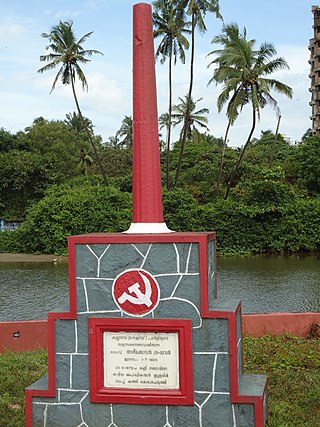
Kannur Beach is a group of five beaches on the western side of Kannur city in Kerala, India. They are:
- Payyambalam Beach
- Meenkunnu Beach
- Adikadalayi Beach
- Baby Beach
- Thayyil Beach

St. Angelo Fort is a fort facing the Arabian Sea, situated 3 km from Canannore (Kannur), a city in Kerala state, south India.
The Sultan Ali Raja or Ali Raja or Adi Raja was the title of the Muslim king of Arakkal kingdom from the sixteenth to early nineteenth century.
Chirakkal Raja was the title of the most senior king of the Chirakkal branch of the Palli division of the Kolathiri dynasty, who ruled over the erstwhile feudal state of Kolathunadu, which was located in the modern-day Indian state of Kerala.

Mappila Bay is a natural harbor situated at Ayikkara in Kannur Municipal Corporation, Kerala state of South India. On one side of the bay is Fort St. Angelo, built by the Portuguese in the 15th century and the other side is the Arakkal Palace.
Thayatheru is a small place in Kannur district of Kerala state, South India. Thayatheru means "the street below". It is near Kannur and is easily accessible via National Highway 17.
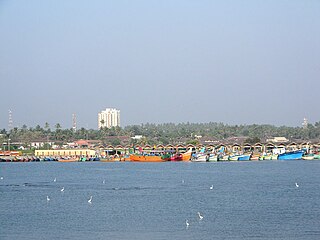
Ayikkara is one of the 55 divisions of Kannur Municipal Corporation in Kannur district of Kerala state, India. Kannur fort, and the Mappila Bay is near Ayikkara.
Kannur Cantonment, situated in Burnassery or Burnshire(the anglicized name), is a cantonment town in Kannur district in the Indian state of Kerala, between Kannur town and Kannur City. The cantonment was a military camp for Portuguese, Dutch and British rulers, and is now the headquarters of Defence Security Corps.

The Arakkal Museum is a museum dedicated to the Arakkal family, the only Muslim royal family in Kerala, India. The museum is actually a section of the Arakkalkettu. The durbar hall section of the palace has been converted into a museum by the Government of Kerala. It was opened in July 2005 after a Rs. 9,000,000 renovation.
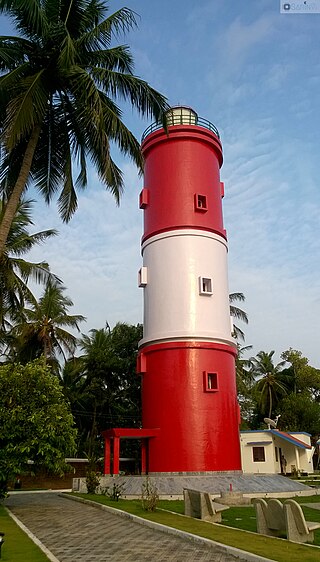
The Kannur Lighthouse is located near the Payyambalam Beach, a few kilometers from Kannur town, in Kerala state, south India. It is adjacent to the Sea View Park and the Government Guest House. The lighthouse is still active and overlooks the Arabian Sea.
Adikadalayi is a village situated 6 kilometers from Kannur town in Kannur district. It is a tourist area located near the village of Edakkad. It is in this village that the famous Kadalayi Sree Krishna Temple is situated. The temple attracts thousands of devotees from far and near. Adikadalayi Sri Krishna Temple is located in the heart of Adikadalayi.

Arakkal Kingdom was a Muslim kingdom in Kannur town in Kannur district, in the state of Kerala, South India. The king was called Ali Raja and the ruling queen was called Arakkal Beevi. Arakkal kingdom included little more than the Cannanore town and the southern Laccadive Islands, originally leased from the Kolattiri. They owed allegiance to the Kolattiri rulers, whose ministers they had been at one time. The rulers followed the Marumakkathayam system of matrilineal inheritance, a system that is unique to a section of Hindus of Kerala. Under Marumakkathayam, the succession passes to the male offspring of its female members, in other words from a man to his sister's son and so forth. As the only Muslim rulers in Malabar, they saw the rise of Hyder Ali, de facto ruler of the Mysore Sultanate as the opportunity to increase their own power at the expense of Chirakkal, and invited him to invade Kerala.
Kingdom of Kannur may refer to:

Kannur, formerly known in English as Cannanore, Arabic as Kannanur, and Portuguese as Cananor, is a city and a Municipal Corporation in North Malabar region, state of Kerala, India. It is the largest city in North Malabar, which is the northernmost region of Kerala. It is sometimes identified Kolathunadu, which was ruled by the Kolathiris. In the 12th and 13th centuries there was trade with Persia and Arabia.
Kannur, India has a number of tourist attractions including beaches, hills, temples and other monuments.

The Kannur Municipal Corporation is the municipal corporation that administers the city of Kannur, Kerala. Established in 2015, the Corporation's first mayor was E. P. Latha. Kannur Corporation has two assembly constituencies – Kannur Assembly constituency and Azhikode Assembly constituency – both of which are part of the Kannur parliamentary constituency. The Corporation is headed by a Mayor and council, and manages 78.35 km2 of Kannur city, with a population of about 232,486 within that area. Kannur Municipal Corporation has been formed with functions to improve the infrastructure of town.












